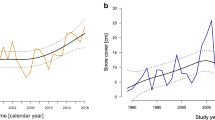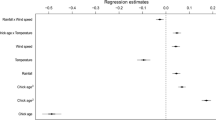Abstract
Winter weather has a strong influence on Barn Owl (Tyto alba) breeding biology. Here, we analyzed the impacts of weather conditions on reproductive performance during the breeding season using data collected over 22 years in a Swiss Barn Owl population. Variations in rain and temperature during the breeding season played an important role in within-year variation in Barn Owl reproduction. An increase in rainfall during the period from 4 to 2 weeks preceding egg laying had a positive effect on clutch size. In contrast, fledgling body mass was negatively influenced by rainfall during the 24 h preceding the measurements. Finally, ambient temperature during the rearing period was positively associated with brood size at fledging. In conclusion, weather conditions during the breeding season place constraints on Barn Owl reproduction.
Zusammenfassung
Der Einfluss der Witterung während der Brutzeit auf die Brutbiologie der Schleiereule ( Tyto alba )
Jährliche Unterschiede im Wetter im Winter und Unterschiede in den Nahrungsbedingungen kurz vor der Brutperiode haben einen großen Einfluss auf die Brutbiologie der Schleiereule. Anhand eines Langzeitdatensatzes von 22 Jahren untersuchten wir verschiedene Wettereinflüsse auf die Fortpflanzungsleistung einer schweizerischen Schleiereulenpopulation. Regenmenge und Temperatur während der Brutsaison spielten eine wichtige Rolle, um den individuellen Unterschied in der Fortpflanzung der Schleiereulenpaare zu erklären. Je mehr es während vier bis zwei Wochen vor Legebeginn regnete, desto grösser war das Gelege. Die Körpermasse der Nestlinge kurz vor dem Ausfliegen war dagegen durch Regen während 24 Stunden vor der Messung beeinträchtigt. Auch hatte die Umgebungstemperatur während der Aufzuchtzeit einen positiven Effekt auf die Anzahl Nestlinge, die bis zum Ausfliegen überlebten. Zusammenfassend kann gesagt werden, dass sich die Wetterbedingungen während der Brutsaison limitierend auf die Fortpflanzung der Schleiereulen auswirken.





Similar content being viewed by others
References
Altwegg R, Roulin A, Kestenholz M, Jenni L (2006) Demographic effects of extreme winter weather in the barn owl. Oecologia 149:44–51
Baudvin H (1986) La reproduction de la chouette effraie Tyto alba. Le Jean-le-Blanc 25:1–125
Bourgault P, Thomas D, Perret P, Blondel J (2010) Spring vegetation phenology is a robust predictor of breeding date across broad landscapes: a multi-site approach using the Corsican blue tit Cyanistes caeruleus. Oecologia 162:885–892
Braaksma S, De Bruijn O (1976) De kerkuilstand in Nederland. Limosa 49:135–187
Carey C (2009) The impacts of climate change on the annual cycles of birds. Philos Trans R Soc Lond B 364:3321–3330
Charter M, Izhaki I, Bouskila A, Leshem Y, Penteriani V (2007) The effect of different nest types on the breeding success of Eurasian kestrels (Falco tinnunculus) in a rural ecosystem. J Rapt Res 41:143–149
Charter M, Meyrom K, Leshem Y, Aviel S, Izhaki I, Motro Y (2010) Does nest box location and orientation affect occupation rate and breeding success of barn owl Tyto alba in a semi-arid environment? Acta Ornithol 45:115–119
Durant JM, Massemin S, Thouzeau C, Handrich Y (2000) Body reserves and nutritional needs during laying preparation in barn owls. J Comp Physiol B Biochem Syst Environ Physiol 170:253–260
Durant JM, Hjermann DØ, Ottersen G, Stenseth NC (2007) Climate and the match or mismatch between predator requirements and resource availability. Clim Res 33:271–283
Durant JM, Gendner J, Handrich Y (2010) Behavioural and body mass changes before egg laying in the barn owl: cues for clutch size determination? J Ornithol 151:11–17
Frey C, Sonnay C, Dreiss A, Roulin A (2010) Habitat, breeding performance, diet and individual age in Swiss barn owls. J Ornithol 152:279–290
Gehlbach FR, Roberts JC (1997) Experimental feeding of suburban Eastern screech-owls Otus asio has few effects on reproduction apart from non-experimental factors. J Avian Biol 28:38–46
Glenn EM, Anthony RG, Forsman ED, Olson GS (2011) Local weather, regional climate, and annual survival of the Northern spotted owl (Clima Local, Clima Regional y Supervivencia Anual de Strix occidentalis caurina). Condor 113:150–158
Haftorn S, Reinertsen RE (1985) The effect of temperature and clutch size on the energetic cost of incubation in a free-living blue tit (Parus caeruleus). Auk 102:470–478
Haywood S (1993) Role of extrinsic factors in the control of clutch-size in the blue tit Parus caeruleus. Ibis 135:79–84
Kim SY, Monaghan P (2006) Effects of early incubation constancy on embryonic development: an experimental study in the herring gull Larus argentatus. J Thermal Biol 31:416–421
Korpimäki E (1987) Timing of breeding of Tengmalm’s Owl Aegolius funereus in relation to vole dynamics in western Finland. Ibis 129:58–68
Lloyd P (1999) Rainfall as a breeding stimulus and clutch size determinant in South African arid-zone birds. Ibis 141:637–643
Martin JM, Branch LC, Raid RN, Beyeler SC (2010) Temporal instability of agricultural habitat reduces reproductive success of barn owls Tyto alba. Auk 127:909–916
Michelat D, Giraudoux P (1992) Activité nocturne et stratégie de recherche de nouriture de la chouette effraie Tyto alba à partir du site de nidification. Alauda 60:3–8
Nager RG, Vannoordwijk AJ (1992) Energetic limitation in the egg-laying period of great tits. Proc R Soc Lond B 249:259–263
Newton I (1998) Population limitations in birds. Academic, London
Patten MA, Rotenberry JT (1999) The proximate effects of rainfall on clutch size of the California gnatcatcher. Condor 101:876–880
Py I, Ducrest A-L, Duvoisin N, Fumagalli L, Roulin A (2006) Ultraviolet reflectance in a melanin-based plumage trait is heritable. Evol Ecol Res 8:483–489
Reid JM, Monaghan P, Ruxton GD (2002) Males matter: the occurrence and consequences of male incubation in starlings (Sturnus vulgaris). Behav Ecol Sociobiol 51:255–261
Roulin A (2004) The function of food stores in bird nests: observations and experiments in the barn owl Tyto alba. Ardea 92:69–78
Schönfeld M, Girbig G, Sturn H (1977) Beitrige zur Populationsdynamik der Schleiereule, Tyto alba. Hercynia 14:303–351
Serrano D, Tella JL, Ursúa E (2005) Proximate causes and fitness consequences of hatching failure in lesser kestrels Falco naumanni. J Avian Biol 36:242–250
Stokes AW (1950) Breeding behavior of the Goldfinch. Wilson Bull 62:107–127
Taylor IR (1993) Age and sex determination of Barn Owl Tyto alba alba. Ringing Migr 14:94–102
Taylor IR (1994) Barn owls: predator–prey relationships and conservation. Cambridge University Press, Cambridge
Thomson DL, Monaghan P, Furness RW (1998) The demands of incubation and avian clutch size. Biol Rev 73:293–304
Tinbergen JM, Dietz MW (1994) Parental energy expenditure during brood rearing in the Great tit (Parus major) in relation to body mass, temperature, food availability and clutch size. Funct Ecol 8:563–572
Vickery WL, Bider JR (1981) The influence of weather on rodent activity. J Mammal 62:140–145
Weatherhead PJ (2005) Effects of climate variation on timing of nesting, reproductive success, and offspring sex ratios of red-winged blackbirds. Oecologia 144:168–175
Acknowledgments
We are greatly indebted to Henri Etter and the late Martin Epars who helped collect the field data. We thank Dr. Martin Spiess and two anonymous reviewers for helpful comments on a previous draft, and Amélie Dreiss for statistical advice. The study was financed by grants from the Swiss National Science Foundation (grant nos. PPOA-102913 and 31003A_120517 to AR) and the Foundation De Giacomi.
Author information
Authors and Affiliations
Corresponding author
Additional information
Communicated by F. Bairlein.
Rights and permissions
About this article
Cite this article
Chausson, A., Henry, I., Almasi, B. et al. Barn Owl (Tyto alba) breeding biology in relation to breeding season climate. J Ornithol 155, 273–281 (2014). https://doi.org/10.1007/s10336-013-1012-x
Received:
Revised:
Accepted:
Published:
Issue Date:
DOI: https://doi.org/10.1007/s10336-013-1012-x




